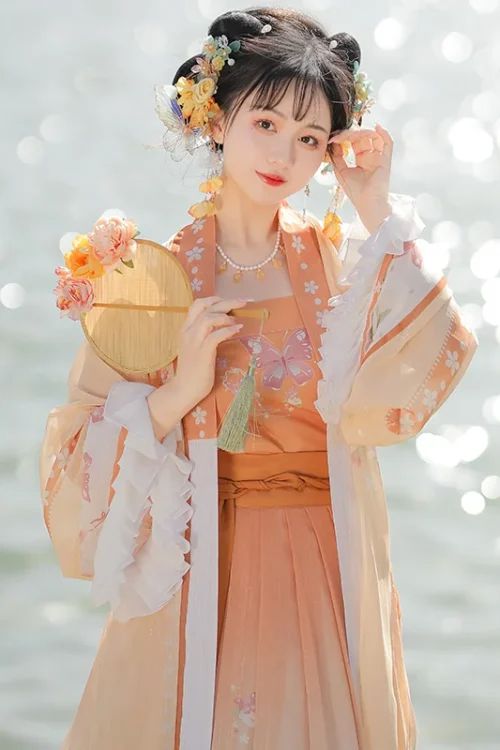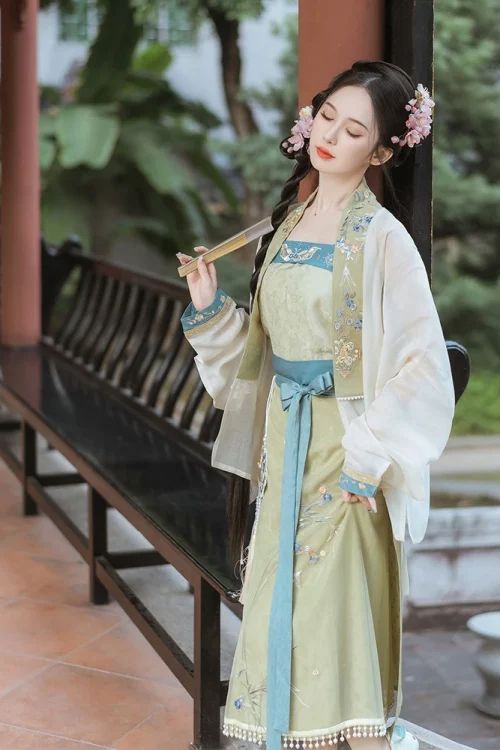The Evolution of Song Dynasty Hanfu: Tracing the Transformation of Ancient Chinese Fashion
Refined Simplicity and Sophistication
The Song Dynasty (960-1279) marked a significant era in the evolution of Chinese fashion, with the emergence of Hanfu that embodied both refined simplicity and sophisticated elegance. This period witnessed a shift from the flamboyant and elaborate styles of the Tang Dynasty to a more understated and graceful aesthetic.

Characteristics of Song Dynasty Hanfu
The Song Dynasty Hanfu was characterized by its flowing lines, soft colors, and intricate embroidery. The garments were typically made from silk or cotton and featured wide sleeves, long skirts, and high waistlines. The colors were often muted and natural, such as white, beige, and light blue, reflecting the prevailing philosophy of harmony with nature.
The Art of Embroidery
One of the most distinctive features of Song Dynasty Hanfu was the use of embroidery. Intricate designs, often depicting flowers, birds, and other natural motifs, were meticulously stitched onto the garments. The embroidery added a touch of sophistication and elegance to the otherwise simple attire.
New Garment Styles
The Song Dynasty also saw the development of new garment styles, such as the “ruqun,” a long skirt with a pleated bodice, and the “beizi,” a short jacket worn over the skirt. These new styles allowed for greater freedom of movement and were particularly popular among women.
Influences on Fashion
The evolution of Song Dynasty Hanfu was influenced by several factors, including the rise of Neo-Confucianism, which emphasized simplicity and moderation, and the growing popularity of literati culture. The literati, or scholar-officials, favored garments that were both practical and aesthetically pleasing, and their preferences had a significant impact on fashion trends.
Lasting Impact
The Song Dynasty Hanfu not only reflected the cultural and aesthetic values of the time but also had a lasting impact on Chinese fashion. Its refined simplicity and sophisticated elegance continue to inspire contemporary designers and fashion enthusiasts alike. Today, Song Dynasty Hanfu is often worn for special occasions, such as weddings and cultural festivals, and serves as a reminder of the rich and vibrant history of Chinese attire.
The Cultural Significance of Song Dynasty Hanfu: Unveiling the Symbolism and Aesthetics of Imperial Attire
A Golden Age of Fashion
The Song Dynasty (960-1279 CE) marked a golden age in Chinese history, renowned for its cultural advancements and artistic achievements. Among its many contributions, the Song Dynasty left an enduring legacy in the realm of fashion through its exquisite Hanfu, the traditional attire of the era.

Unique Blend of Simplicity and Elegance
Song Dynasty Hanfu embodied a unique blend of refined simplicity and sophisticated elegance. Unlike the elaborate and ornate garments of previous dynasties, Song Hanfu emphasized clean lines, flowing silhouettes, and subtle embellishments. The use of natural fibers, such as silk, cotton, and linen, created a soft and ethereal aesthetic.
Color Palette and Patterns
The colors of Song Hanfu were typically muted and understated, with shades of white, beige, gray, and blue predominating. These hues reflected the Song Dynasty’s appreciation for nature and its emphasis on harmony and balance. The garments were often adorned with subtle patterns, such as floral motifs or geometric designs, which added a touch of sophistication without overpowering the overall simplicity.
Meticulous Craftsmanship
The construction of Song Hanfu was meticulous and intricate. The garments were typically tailored to the individual wearer, ensuring a perfect fit. The use of fine fabrics and skilled craftsmanship resulted in garments that were both comfortable and visually appealing.
Symbolism in Attire
Beyond its aesthetic qualities, Song Dynasty Hanfu also held significant cultural and symbolic value. The different styles and colors of Hanfu denoted the wearer’s social status, occupation, and even marital status. For example, officials wore formal robes with elaborate embroidery, while commoners wore simpler garments made from less expensive materials.
Reflections of Scholarship
The Song Dynasty’s emphasis on education and scholarship was reflected in the Hanfu worn by scholars. Their robes were often adorned with auspicious symbols, such as cranes or clouds, which represented longevity and wisdom. Women’s Hanfu also carried symbolic meanings. Married women wore skirts with long, flowing trains, while unmarried women wore shorter skirts with more vibrant colors.
Conclusion: Cultural Pinnacle
In conclusion, Song Dynasty Hanfu represents a pinnacle of Chinese fashion and cultural expression. Its refined simplicity, sophisticated elegance, and symbolic significance continue to inspire designers and fashion enthusiasts today. By exploring the intricacies of Song Hanfu, we gain a deeper understanding of the cultural and aesthetic values that shaped one of China’s most celebrated eras.
The Revival of Song Dynasty Hanfu: Exploring the Modern Renaissance of Traditional Chinese Clothing
A Cultural Renaissance
The Song Dynasty (960-1279) marked a golden age in Chinese history, renowned for its cultural and artistic achievements. Among its many contributions, the Song Dynasty left an enduring legacy in the form of Hanfu, the traditional clothing of the Han Chinese people.

Characteristics of Song Hanfu
Song Dynasty Hanfu embodied a unique blend of refined simplicity and sophisticated elegance. Unlike the elaborate and ornate garments of previous dynasties, Song Hanfu emphasized clean lines, flowing silhouettes, and subtle embellishments. The use of natural fibers, such as silk, cotton, and linen, created a soft and ethereal aesthetic.
Structure of Song Hanfu
The basic structure of Song Hanfu consisted of a long, loose robe known as a “pao” for men and a “ruqun” for women. These robes were typically worn over a long, narrow skirt or trousers. The pao and ruqun were often adorned with subtle embroidery or woven patterns, adding a touch of sophistication without overwhelming the overall simplicity.
Color Palette
One of the defining characteristics of Song Hanfu was its use of color. While previous dynasties favored bright and vibrant hues, Song Hanfu embraced a more muted and refined palette. Earth tones, such as brown, green, and blue, were commonly used, along with soft pastels and shades of white. This subtle color scheme created a sense of harmony and balance.
Accessories and Elegance
The accessories worn with Song Hanfu also reflected the dynasty’s emphasis on elegance and restraint. Women often adorned their hair with delicate hairpins and combs, while men wore simple headwear such as caps or turbans. Jewelry was typically understated, with a focus on natural materials such as jade and pearls.
A Modern Movement
The revival of Song Dynasty Hanfu in modern times has sparked a renewed appreciation for the beauty and sophistication of traditional Chinese clothing. Hanfu enthusiasts have dedicated themselves to studying and recreating the garments of the Song Dynasty, using authentic materials and techniques.
Cultural Identity and Pride
The modern Hanfu movement has not only revived an ancient tradition but has also fostered a sense of cultural identity and pride among Chinese people. By embracing the refined simplicity and sophistication of Song Dynasty Hanfu, modern Hanfu enthusiasts are connecting with their cultural heritage and celebrating the enduring legacy of Chinese artistry.
